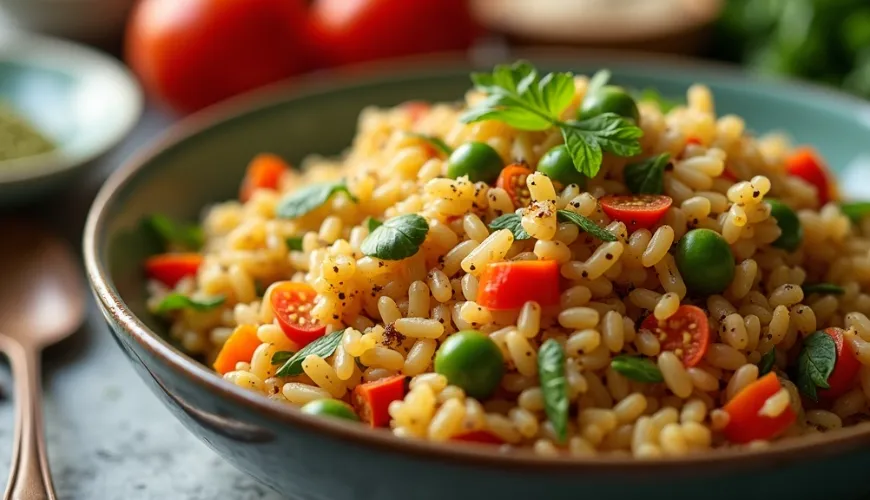
Find out why pilaf should be a part of your diet

Pilaf, also known as pilav, is a delicious dish that is prepared in various forms around the world. From the Middle East through the Balkans to India and Central Asia – each region has its own version of this simple yet incredibly tasty specialty. In Czech kitchens, it is still rather rare, which is a great pity. Rice pilaf is not only easy to prepare but also perfectly versatile. It can be vegetarian, meaty, spicy, or mild, and always offers room for seasonal ingredients and creativity.
Thanks to its simple base structure – rice, broth, aromatic vegetables, and often some source of protein – pilaf is great for both a quick weeknight dinner and a more festive table full of aromas and colors. Whether you prefer a version with vegetables, chicken, or exotic spices, pilaf can win the heart of anyone who tastes it.
What is pilaf and why you should care
The basis of pilaf is rice toasted in fat along with onions, which is then simmered in broth. In this way, the rice is coated in fat, the grains remain fluffy, and each one absorbs the aroma of spices and other ingredients. This method of preparation is typical for, for example, Uzbek plov, Turkish pilav, or Indian pulao. Although the names differ, the principle remains very similar – and the result is always worth it.
The reason pilaf deserves attention is not just its great taste and simplicity. It is also one of the healthier meals if prepared with quality ingredients. You can easily adapt it to your needs – gluten-free, vegan, with whole grain rice, or with the addition of legumes.
Moreover, it's a dish that fits perfectly with the zero waste approach to cooking. Leftover vegetables, a small piece of meat, or a portion of broth from the fridge – all of this can be transformed into a tasty vegetable pilaf or a hearty chicken pilaf that will satisfy the whole family.
Rice pilaf as a versatile base
If we had to choose just one type of pilaf to start with, it would definitely be rice pilaf with onions and root vegetables. This basic recipe can easily be adjusted according to the season. In summer, it's good to add zucchini, tomatoes, or peppers, in autumn pumpkin and mushrooms, in winter perhaps beets, kale, or Brussels sprouts.
The special charm of pilaf also lies in its aroma. The combination of garlic, onion, carrot, and possibly spices like cumin, turmeric, or cinnamon can transform ordinary rice into a true gastronomic experience. And if you use homemade broth instead of water, you'll elevate the flavor even further.
A simple recipe for vegetable pilaf might look like this:
Basic Vegetable Pilaf
- 1 cup long-grain rice (e.g., basmati)
- 2 cups vegetable broth
- 1 onion, finely chopped
- 1 carrot, grated
- 1 clove of garlic
- 2 tablespoons olive oil
- salt, pepper, turmeric, cumin
- fresh parsley for garnish
First, sauté the onion in oil, add garlic, carrots, and spices. Then add the rice and briefly toast until it starts to smell fragrant. Pour in the broth, cover with a lid and let simmer on low heat until the liquid is absorbed. Finally, fluff with a fork and add chopped parsley.
This pilaf is great as a light main course or side dish. You can complement it with baked tofu, sautéed chickpeas, or a poached egg for a balanced plate.
Chicken pilaf – a classic that never disappoints
If you're looking for something more filling, a great choice is chicken pilaf. Gently spiced chicken pairs excellently with rice and vegetables, without burdening the body like heavier saucy dishes. The preparation is again simple and efficient – ideal for weekday evenings or a quick lunch.
In traditional Uzbek cuisine, chicken pilaf is prepared in a cast iron pot, where the meat is first sautéed with onions and spices, then rice and broth are added. However, modern versions can easily be adapted for home conditions and regular pans.
One mother of two, who cares about healthy eating, shared her favorite trick: "I use leftover chicken from dinner and add it to the rice pilaf the next day. The kids love it and I don't have to waste even a piece of meat."
This philosophy of maximizing food use is not only practical but also sustainable. At a time when food waste is a global issue, pilaf can be an example of a simple yet effective solution.
Pilaf as a gateway to other cultures
One of the reasons pilaf has become so popular worldwide is its ability to adapt to local tastes and available ingredients. In India, you find versions with cardamom, cinnamon, and saffron, in Iran with raisins and pistachios. In the Balkans, tomatoes and peppers are often added, in Turkey, a common combination is with lentils or bulgur.
This diversity is an inspiration – every household can create its own pilaf recipe that fits their taste, budget, and time constraints. It suits both a festive table and a quick one-pan meal.
And precisely because of its diversity and friendliness to various dietary needs, pilaf has the potential to become a common part of the menu here as well. Moreover, it is a dish that brings the family together at the table – fragrant, colorful, shared. In many cultures, pilaf is served at celebrations, weddings, or family gatherings. It is a symbol of hospitality, abundance, and care.
How to start preparing pilaf at home
You don't need special equipment or exotic ingredients. To start, all you need is a quality pan, some rice, vegetables, and basic spices. If you want to treat yourself to something extra, you can add toasted almonds, raisins, dried apricots, or diced sweet potatoes.
It's important to pay attention to toasting the rice – this step ensures that the result won't be mushy, but beautifully fluffy. Don't be afraid to experiment. Every batch of pilaf can be a little different – and that's where its beauty lies.
When choosing ingredients, go for those in season. In winter, add cooked pumpkin or roasted root vegetables. In summer, cherry tomatoes, corn, or spinach. And if you have a garden, pilaf is an ideal way to use up excess harvest.
Pilaf is more than just a rice dish. It is a reminder that even simple things can be beautiful and exceptional. You just need to give them time, care – and a little room for imagination.

